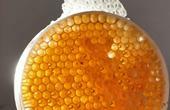Sweeteners and sweeteners

At home, from time immemorial, substances that have a sweet taste, so-called sweeteners, have been widely used in cooking and cooking. One of the first among these substances were fruits of plants, honey and juices. Sucrose is the basic sweet substance that we use.
In connection with the requirements of the science of nutrition, as well as the increasing number of patients who are contraindicated in high-calorie foods( primarily people who suffer from diabetes mellitus), the production of low-calorie food products has recently expanded. In such low-calorie foods, substitutes for sucrose, both natural and synthetic, are used. In the culinary industry, the use of starch products increases: molasses( low-sugar molasses, caramelic syrup, glucose syrup), glucose-fructose syrups, glucose.
Honey is a traditional sweetener. Honey is a product of processing flower nectar of honey-colored flowers by bees. It has a pleasant taste and smell. Its color, composition and aroma are largely determined and differentiated by the plants from which it was harvested. Honey contains 75% of mono- and darcharides, including about 40% fructose, 35% glucose, 2% sucrose and 5.5% starch. From vitamins in honey there are vitamin C - 2.0 mg per 100 g, B6 - 0.1 mg per 100 g, folacin - 15.00( μg), insignificant amount of B2, B1.Also, honey contains trace elements( μg /%), iron - 800, iodine - 2.0, fluorine - 100, organic acids - 1.2%.
Honey is widely used in the confectionery industry, as a food product, medicine, as well as in the manufacture of beverages.
Malt extract is a water extract from barley malt. Malt extract consists of a mixture of mono-, oligosaccharides( sucrose, fructose, glucose, maltose), minerals, proteins and enzymes. In the malt extract, the sucrose content is about 5%.Malt extract is used to make confectionery and various food products.
Saccharin is a synthetic substance. It is sweeter than sucrose 300-500 times, so its dosage is very small. Saccharin quickly passes through the digestive tract.98% of saccharin is excreted in the urine. For 1 kg of the product is allowed to use saccharin in the amount of 5 g. The harmlessness of saccharin to the end has not yet been established. For this reason, it is recommended to limit the use of saccharin. Saccharin is used in the production of dietary food for patients with diabetes mellitus, dietary cheeses, beverages and chewing gums.
aspartame contains the residue of aspartic and phenylalanine amino acids. Aspartame consists of two amino acids( dipeptide).Aspartame is partially converted into a diketopiperazine substance during the preparation of food products. It is used to sweeten ice cream and creams, which do not require heat treatment, as well as products of therapeutic nutrition. Because of the decrease in the degree of sweetness of aspartame, it is not recommended to store it for a long time. Aspartame is considered safe. He underwent a thorough check for carcinogenicity, mutagenicity and safety.
Stable connections for cooking and baking are called cyclamates .Cyclamates dissolve well in water. They are sweeter than sucrose 30 times. Cyclamate sodium and calcium cyclamate are used. These compounds are widely used in the confectionery industry of a number of countries.
Polyhydric alcohols ( polyols).So-called sugar alcohols sorbitol and xylitol are used very widely. The sugar content of xylitol is 0.85 compared with sucrose. And sugariness of sorbitol in comparison with sucrose makes 0,6.When administered orally, sorbitol is rapidly absorbed. In the liver, it turns into fructose and increases the glycogen content. Also sorbitol has a cholagogue effect. It is used as a remedy for biliary dyskinesia, cholecystitis, colitis with a tendency to constipation. But in large doses sorbitol has the opposite effect - it causes diarrhea and inhibits bile secretion.
Xylitol is a five-atom alcohol. By its action is similar to sorbitol. Xylitol is used as a remedy for cholecystitis.
Materials used:
Shilov VN, Mits'yo VP"Healthy food"
